

One of the recurring features of past seasons of AI Survivor have been our "alternate histories", running additional iterations on the same maps to see if the same events would play out again. The first playoff game of Season Three saw Stalin and Justinian run over the rest of the field in a violent bloodbath. Was that something which would unfold in each game? This was a topic that called for more investigation with alternate history scenarios. Following the conclusion of previous seasons of AI Survivor, I had gone back and investigated some of the completed games and found that they tended to play out in the same patterns over and over again. While there was definitely some variation from game to game, and occasionally an unlikely outcome took place, for the most part the games were fairly predictable based on the personality of the AI leaders and the terrain of each particular map. Would we see the same patterns play out again and again on this particular map?
The original inspiration to run these alternate histories came from Wyatan. He decided to rerun the Season Four games 20 times each and publish the results. The objective in his words was twofold:
- See how random the prediction game actually is. There's a natural tendency when your predictions come true to go "See! Told you!", and on the contrary to dismiss the result as a mere fluke when things don't go the way you expected them to (pleading guilty there, Your Honour). Hopefully, with 20 iterations, we'll get a sense of how flukey the actual result was, and of how actually predictable each game was.
- Get a more accurate idea of each leader's performance. Over 6 seasons, we'll have a 75 game sample. That might seem a lot, but it's actually a very small sample, with each leader appearing 5-10 times only. With this much larger sample, we'll be able able to better gauge each leader's performance, in the specific context of each game. So if an AI is given a dud start, or really tough neighbours, it won't perform well. Which will only be an indication about the balance of that map, and not really about that AI's general performance. But conversely, by running the game 20 times, we'll get dumb luck out of the equation.
Wyatan did a fantastic job of putting together data for the Season Four games and I decided to use the same general format. First I'll post the resulting data and then discuss some of the findings in more detail. Keep in mind that everything we discuss in these alternate histories is map-specific: it pertains to these leaders with these starting positions in this game. As Wyatan mentioned, an AI leader could be a powerful figure on this particular map while still being a weak leader in more general terms. Now on to the results as run by TheOneAndOnlyAtesh:
Game One | Game Two | Game Three | Game Four | Game Five
Game Six | Game Seven | Game Eight | Game Nine | Game Ten
Game Eleven | Game Twelve | Game Thirteen | Game Fourteen | Game Fifteen
Game Sixteen | Game Seventeen | Game Eighteen | Game Nineteen | Game Twenty
(Note : "A" column tracks the number of war declarations initiated by the AI, "D" the number of times the AI is declared upon, "F" the points for finish ranking, and "K" the number of kills.)
TheOneAndOnlyAtesh: After the first four games, every indication was that this was going to be a complete Justinian stomp. Then the next sixteen games completely flipped the script, suggesting a wild and unpredictable setup in which the four corner leaders - going clockwise from the Northeast, Stalin, Justinian, Hammurabi, and Wang Kon - were all meaningful contenders in this map. In hindsight, this was not an unreasonable result. One could draw a line from the NW to the SE corner to divide the map into two equally sized factions, the bottom/left one being occupied by the "Jedi" (Wang Kon/Hammurabi/Asoka) and the top/right one occupied by the "Sith" (Justinian/Stalin/Shaka). Alongside the two contenders, each faction had one leader, Asoka for the Jedi and Shaka for the Sith, who had drawn the short ends of the sticks, getting stuck between the crossfire in their central positions and thus being too battered to ever have any prospects in this map.
Map Dynamics
Whichever faction came on top in these galactic showdowns SOLELY hinged on how effectively Asoka was able to resist the Death Star that was pointed towards him at all times. In fact, Turn 200 was ALWAYS the critical inflection point of the game. I know only a Sith deals in absolutes, but this absolute statement was no exaggeration: Justinian or Stalin won every single game where Asoka died before Turn 200, while every single victory by the Jedi saw Asoka hold out for at least 200 turns - in particular the Troll King's four wins all coincided with Asoka's four survivals. There was only one exception to the Rule Of Two Hundred (Game 17), where Stalin came up victorious despite Asoka making it to Turn 241. However, that exception proved the rule: the Evil Empire uncharacteristically focused its stormtroopers on Hammurabi instead, therefore knocking out a Jedi on Turn 191 to pave the way for the Empire to strike back.
The Jedi, to their own detriment, could be baited into hastening Asoka's demise. Much temptation, the dark side brings!
If/when Asoka collapsed early, his amazing land would help the Sith keep up in tech with the Jedi and thus win with their superior fighting abilities. Conversely, if Asoka held on for long enough, then the Sith would fall behind and the Jedi would have a technologically superior army to claim victory with. To their credit, the good guys did not sit idly in these games, frequently attempting and succeeding in their own conquests. In particular, they had their own weakling to pick on: Shaka. The Zulu king, who had the double whammy of a central position and awful land, was the Sith counterpart to Asoka in this galaxy far, far away, and a Jedi won every single game in which Shaka was First To Die, partially because that relieved a lot of pressure from Asoka.
Asoka dying early did not necessarily spell doom for the high peaceweights. To give some examples, there was Game 11, where Justinian went on to secure dominion of the South while Wang Kon became Grandmaster of the North before launching a premature attack to cede Domination to the Byzantines, and Game 16, where Hammurabi was the tech leader but Stalin was able to clutch a UN victory before he fell too far behind. Note that those games also saw Shaka die relatively early - it was no accident that because of that, a Jedi still secured a Championship spot.
Furthermore, both Jedi and Sith were prone to infighting, the former due to religious differences (all three leaders liked to found religions), and the latter due to, well, betrayal being a core Sith tenet; there was a reason Darth Bane eventually created the Rule of Two. Betrayal led to varying degrees of success for each faction. In Game 6, Stalin backstabbed Justinian while the Byzantine army was deep in Babylon and pulled off one of the greatest tactical maneuvers I have ever seen from an AI: he chased Justinian's troops into the Soviet borders, then, with the help of the Babylonian forces, encircled his foe and wiped out his entire stack of doom, leaving the Byzantines defenseless and easy pickings. Meanwhile, in Game 18, untimely barbarian city spawns caused Wang Kon to have an unusually weak game. Hammurabi took advantage by conquering Korea for the earliest elimination of the set and snowballing from there, while Asoka did his job as the sacrificial lamb and held on for long enough. Better Hammurabi got that territory than Shaka or Stalin.
Betrayal did backfire for both sides as well. In Game 5, Stalin backstabbed Justinian before the Byzantines could make any noticeable progress on Asoka, and although Justinian straight up crushed both of his enemies in the 2v1, it took long enough that the Hammurabi-Wang Kon duo had become tech runaways. For the Jedi, the mandate was this: DO NOT, UNDER ANY CIRCUMSTANCES, ATTACK ASOKA.  In Game 11, for example, Hammurabi turned to the dark side and helped the Sith devour Asoka, before they then turned on the Babylonians.
In Game 11, for example, Hammurabi turned to the dark side and helped the Sith devour Asoka, before they then turned on the Babylonians.
Leader Dynamics
There were four viable leaders, which meant there were four scripts for these games. The most standard archtype was the Justinian/Stalin (or occasionally Shaka)/Asoka First to Die (FTD) game. These games went like this: Stalin and Justinian become brothers in the faith and overwhelm Asoka with sheer force of numbers, Justinian getting the emperor's ransom. Justinian could then easily coast to victory while Stalin dutifully played the role of enforcer. In some rare circumstances, Shaka sometimes successfully killed Wang Kon early which gave him an opportunity to supplant Stalin as the enforcer (Games 3, 10).
Next, there were the Stalin/Shaka ticket games. These games came when Stalin, rather than Justinian, got most of the spoils from the Asoka partition. With the Byzantine Emperor shunted into his corner, he did not fare well in these games, as he would eventually be on the receiving end of Darth Mustache's Cossacks. This left Shaka to fill the void; only two there are, after all. Overall, the low peaceweight games which comprised the majority of replays generally exposed the military weaknesses of the high peaceweight leaders. The issue with the Jedi stemmed not so much from their innate fighting abilities, but from their preparedness for war. It was not uncommon for a Jedi to delay crucial military techs or to tie their build queues on wonders and missionaries when a doom stack of Cataphracts or Cossacks was building on their borders.
The Wang Kon/Asoka/Shaka FTD scenario took place four times. These games saw Wang Kon mow down Shaka with Hwatchas while Asoka held strong to ensure that his excellent land could vault him to the Championship Game. Unfortunately for the Indian leader, the neverending fighting would leave him so exhausted that Wang Kon, whose wars were much more rewarding and less destructive, would leverage his Financial trait and amazing post-Iron Working land (especially with those gems resources) to victory. A common feature of these games was the weakness of Justinian's would-be enforcers. Shaka and/or Stalin would over-expand, ignore culture for too long, and ruin their economies, ensuring that they were too ineffective to be of any help to Justinian. These games also tended to see Sith infighting mar the Evil Empire's plans. These games accounted for every single one of Asoka's Championship appearances, and he was only ever on pace to win in Game 19 until some Troll King shenanigans happened (more on that in the leader discussion). Interestingly, Hammurabi flailed around in the Wang Kon games, suiciding into the Koreans in Games 8 and 14, throwing away a potential Championship Game spot in Game 19 with a foolish UN vote, and requiring the UN to save him from Asoka in Game 20. I am unsure why a good Wang Kon game seemed to always coincide with a bad Hammurabi one.
The fourth and wackiest game archetype was the Hammurabi game. Although these three games were the strangest of the set, there were two patterns: 1) a weak Wang Kon, whether it was due to poor expansion or his inability to handle Shaka, and 2) an Asoka who, while eventually dying, would hold out long enough that Hammurabi was too far ahead by the time the Death Star reached his orbit. Justinian's two Runner Up finishes in this set came in Hammurabi games - this was no coincidence, as often Justinian would have conquered Asoka to get enough territory to be top two in score.
There were also a couple of hybrid games, that being Games 11 (Justin/WK) and Games 16 (Stalin/Hammurabi) which I had gone into detail about earlier in this writeup.
Overall, the tech pace was average, as although this was not the most inspiring group of techers (I was especially surprised at how mediocre Justinian's econ was), the land overall was quite nice and there were significant conquest opportunities to aid snowballs. Religion played a significant role in these games, ensuring the inevitability of the Justinian-Asoka conflict and being the primary sower of discord between the Jedi. Religion was also a double-edged sword for Justinian, as his zealotry sometimes blinded him to the untrustworthiness of his fellow Sith or caused him to choose suboptimal war targets, especially through cross map wars.
Spaceship and Domination were the only realistic ways a game could finish, with the Sith generally opting for Domination and the Jedi generally opting for Space. There were two Diplomatic finishes, but they were both questionable. Stalin deserves some credit for his Game 16 win, as he had brute forced his way from a bad start to become the land and score leader, but Hammurabi was far enough ahead in tech that he would have won had Justinian not elected Stalin as World Leader. As far as Wang Kon's Game 19 win went, well, stay tuned. There was one Cultural finish, but it stemmed from the game stretching long enough that Hammurabi with his pure Culture research flavor pretty much accidentally won without ever turning up the slider. Otherwise, the religions were far too split, and the games far too violent, for there to be any realistic possibility of a Cultural finish.
How Typical Was The Actual Game?
3/10. In many facets, the livestream game played like a standard Justinian game... except 1) Justinian kind of got Wang Konned, and 2) Stalin somehow got the vast majority of the spoils of war despite Justinian doing most of the work. Stalin winning with Justinian coming in 2nd place was an extremely atypical result - a Stalin victory required a crippled Justinian and always came with either Shaka or Hammurabi in 2nd place - and furthermore, he actually earned his wins with good play, rather than being at the right place at the right time.
Another thing to note was that Asoka actually held on past the Turn 200 deadline in the official game. Troll Kon definitely had something to do with this, as Justinian's weird cross map attack caused the Livestream to go completely haywire and effectively paused the game for another 50 or so turns. Game 1 was extremely similar to the Livestream and played out like a "How The Actual Game Should Have Ended" scenario.
Analyzing the individual leaders:

Justinian of Byzantium
Wars Declared: 48
Wars Declared Upon: 21
Survival Percentage: 80%
Finishes: 9 Firsts, 2 Seconds (49 points)
Kills: 20
Overall Score: 69 points
Justinian was the Senate in this setup, the most powerful and feared Sith on the map. However, I had a feeling that his insane start, where he won the first four games, was a tad flukey, as those four games saw some incredibly incompetent play from all three of the high peaceweights - economic mismanagement, wonder lalaland, Rifling avoidance, etc. Game 1 in was especially embarrassing for the Jedi, as both Hammurabi and Wang Kon were tech runaways but lost because they were still sporting Medieval armies despite having teched all the way to Assembly Line.
The next sixteen games revealed two major issues for the Byzantine emperor that prevented him from truly dominating this field. To start, he only had one pathway to victory: kill Asoka ASAP. Fail to do so, and he was out of contention. There really was no other way, as a Jedi won the two games where Justin instead killed Stalin early (Games 5, 14), and if another leader killed Asoka, Justinian's core was just not enough. Every turn not completely dedicated to wiping out the Indians was precious time for the Jedi to develop, and Shaka was a poor replacement enforcer in this map.
Justin's other flaw was that he had great difficulty spreading his religion, as Asoka rarely gave him open borders and there were many other competing faiths. As a result, he could not rely on shrine income, and his overall economy suffered. His only religious ally was Stalin, and we all know that Darth Comrade does not make for the best religious partner. Nevertheless, Justinian's results speak for themselves here: as the most balanced leader with the easiest access to the softest target on the map, he was the most successful leader here, even if he was rather streaky in these games. It also spoke volumes that he was the only leader in this field to survive the majority of replays, although his survival rate was deceiving - there were at least two games where he was on his way out when another leader's victory had triggered. Justin showcased his championship pedigree, but this was not the easiest setup for the Byzantine leader.
Best Performance: Game 13, where Justinian brute forced his way through Asoka and snowballed from there.
Worst Performance: Justin foolishly tried to continue his conquest of Babylon in Game 6 while facing an existential threat from Stalin, and getting tactically outmaneuvered to his doom.
Sitting Bull Award:

Stalin of Russia
Wars Declared: 55
Wars Declared Upon: 25
Survival Percentage: 50%
Finishes: 4 Firsts, 6 Seconds (32 points)
Kills: 22
Overall Score: 54 points
The burning question for all readers: was Stalin's championship run legitimate? His Opening Round alternate histories were a mixed bag, as while he was a great 2nd place contender (and was effectively 2nd place in the real Opening Game One, only winning due to Diplo cheese) and had some bad barbarian luck, he had some stinkers and his output did not exactly scream "champion". What about his Playoff set?
Well, with the Soviet leader securing a top two spot in half these replays, including four mostly well-earned victories (even his semi-troll Diplo Game 16 was a very well played game by the Soviet leader), these results should quiet any naysayers for the time being. Stalin was a perfect number two behind Justinian, with all of his runner up finishes coming behind the Byzantines. Moreover, his pathway to victory was simple: take most of India, wall off Justinian, and then turn on his former master, becoming the Sith Emperor himself with Darth Shaka as his apprentice. Stalin may be a bit of a meme champion, but one cannot deny his military prowess.
Stalin did have an extraordinarily binary set of outcomes, however, dying in all ten games where he did not advance. There were generally three reasons for his failures. First, he could have a bad early game due to his infamous propensity to avoid culture, exacerbated by the removal of Deity starting techs. Admittedly, his culture avoidance was not always a bad thing, as it allowed him to zig on military while his relevant competition zagged on wonders and religion. Nevertheless, there was a concerning number of games where Stalin was a non-entity by Turn 100 because too many of his cities had lost control of their first ring tiles. A weak Stalin was instrumental in many of the successful Jedi games. Secondly, if Stalin ever came to blows with Justinian early, it was a disaster for the Soviets. Although Stalin was only First To Die once (Game 5), he came exceedingly close to another one in Game 14, going out one turn after Shaka. Those two deaths were both solely at the hands of the Byzantines, and they were related to the first reason in that Stalin could be provoked prematurely by Byzantine border tensions. Finally, if Shaka knocked out Wang Kon early, the Soviets could find themselves wedged between two large leaders, eventually getting squeezed out of contention. The Rule of Two made itself apparent here, as Darth Shaka would replace the Soviet dictator as Justinian's apprentice. All in all, Stalin's strengths and weaknesses were on full display in these games. Nevertheless, this set does add a lot of credibility and legitimacy to his title run, one that leaves him a Pool One leader to this day (post Season 8).
Best Performance: Game 12 saw Stalin build up well, run over Asoka, and even get a strong economic performance to boot. The cherry on top: in a late game Defensive Pact triggered war, Stalin destroyed Shaka and Justinian at the same time, even though their borders surrounded his territory.
Worst Performance: His one First To Die flameout in Game 5 was extremely embarrassing, getting run over despite being on the right side of a 2v1.
A Million Deaths Is a Statistic Award:

From Stalin's Game 6 victory.
What Happens When All Of Your Advisors Mysteriously Disappear Award:
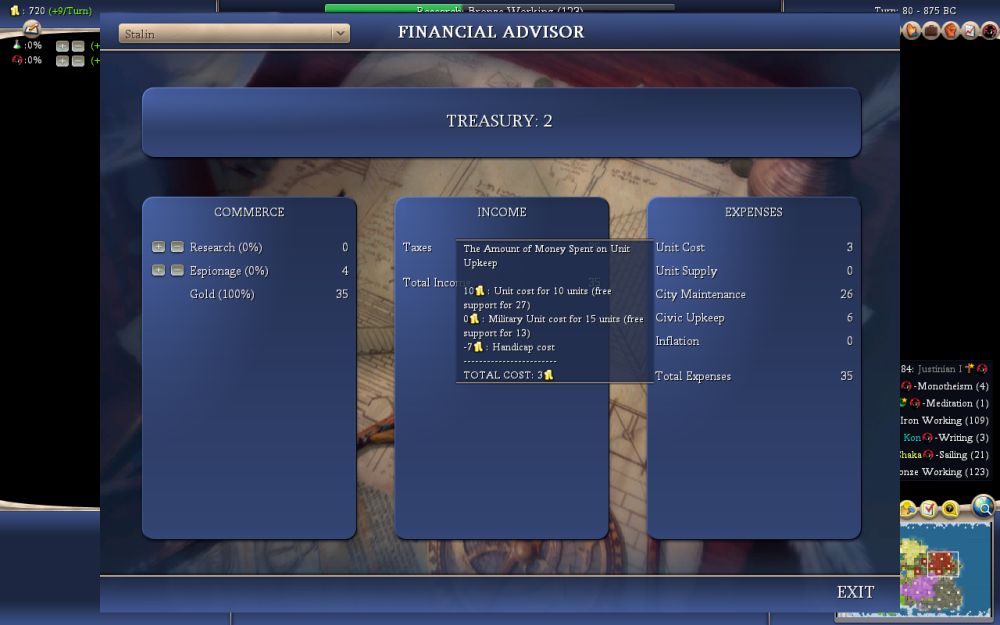
So much for the glorious worker's revolution.

Wang Kon of Korea
Wars Declared: 18
Wars Declared Upon: 58
Survival Percentage: 30%
Finishes: 4 Firsts, 2 Seconds (24 points)
Kills: 13
Overall Score: 37 points
Wang Kon was the light side counterpart to Justinian, down to the game-changing unique unit, and his presence was essential for the success of the high peaceweight leaders due to his above average aggression rating and his resilient fighting. Wang Kon's relative success may seem surprising at first, as the Troll King was squeezed into a jungle-choked corner with Shaka breathing down his neck. Making matters worse was that Wang Kon lacked Copper, leaving him even more exposed to the Zulu hordes.
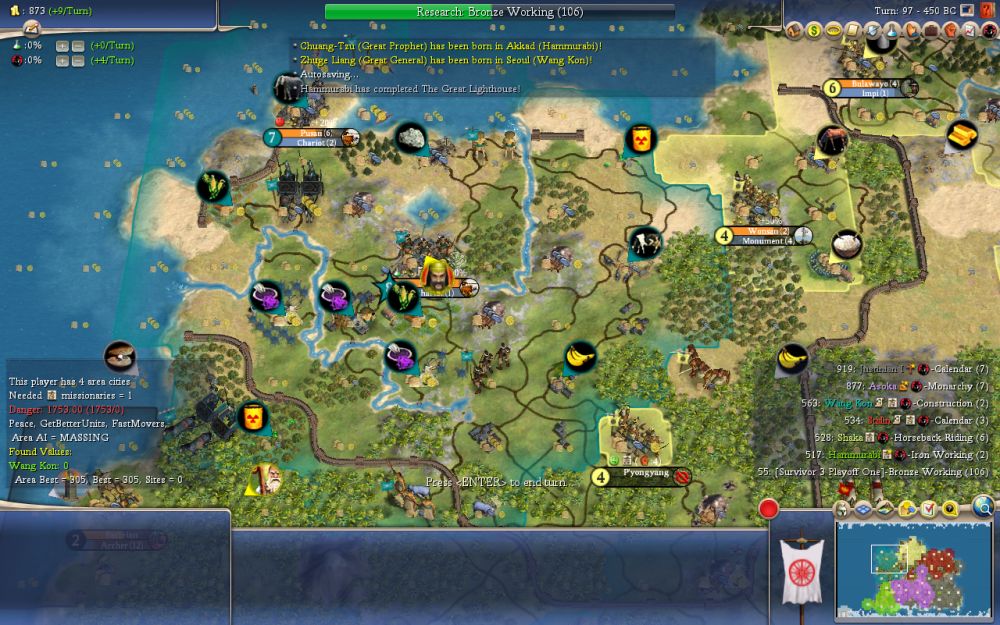
Stop building Chariots! You are Protective! 
However, Wang Kon's land scaled extremely well once he had chopped down the jungle and researched Calendar. More importantly, Wang Kon could utilize his Protective trait and his Hwatchas to fight his way out of his corner. People criminally underrated the unit perhaps due to it being saddled with a Protective leader (yes, even Financial cannot redeem Protective). I am unsure if Wang Kon would be nearly as successful here without his unique unit. The Korean leader also maximized his expansion opportunities, fitting cities into every nook and cranny he could find and quickly seizing the barbarian cities that frequently sprouted nearby.
Much hinged on the location of Wang Kon's border cities. Sometimes, he would settle them on flat ground, a strategic error that made his empire much more difficult to defend, causing his worst games. However, if he settled his border cities on hills, it was extremely difficult for Shaka to break through his Protective + religious culture + melee shredding Hwatcha boosted defenses, even if the Koreans lacked metals. Time was on Wang Kon's side; the longer he held, the more likely it was that he would conquer the Zulus. From there, he could shine as the best economic leader in the field, Financial/Aliving his way to success, and also become Asoka's savior. Admittedly, he needed some luck to break his way, namely for Asoka to also hold tall against the might of the Evil Empire. It did not matter how good his tech was if the bad guys already had half the map under their control. Although Wang Kon is most infamous for his trolling antics (especially this season), this set suggested a leader capable of finding some success if he can corral his self-sabotaging tendencies - a big if, of course.
Best Performance: Game 20 was his best military and economic performance, and it was also one that did not rely as much on outside map factors - Wang Kon just earned it.
Worst Performance: While I can excuse his Game 18 elimination as stemming from ill-timed barb city spawns, he just absolutely wilted in Game 10 to Shaka.
Trollbi Wang Konobi Award: In true Troll King fashion, Wang Kon sniped Asoka's one chance to win in Game 19 through Diplomatic Victory shenanigans. Seriously, I felt so bad for Asoka here, the Indian leader was actually the tech runaway for once after being battered so hard in the other games and he really deserved a victory for his troubles. KKKKKKOOOOOOOOOONNNNNNNNN!

Hammurabi of Babylon
Wars Declared: 21
Wars Declared Upon: 24
Survival Percentage: 35%
Finishes: 3 Firsts, 1 Second (17 points)
Kills: 5
Overall Score: 22 points
If Wang Kon was the master, Hammurabi was his most talented apprentice. The Troll King may have been too good of a teacher, however, as Hammurabi was an unstable Jedi, prone to turning to the dark side and ruining the best laid plans of the good guys. This set only strengthened my belief that Hammurabi might be the most poorly designed leader in Civ IV, both in human and in AI hands. One cannot expect a guy to do well when he beelines Radio before Rifling and yet has Spaceship as his default win con and traits that lend themselves towards aggression.
As implied above, all of Hammurabi's victories saw him turn on one or more of his fellow Jedi at some point. Sometimes, like in Game 18, such betrayals were shrewd moves, as his friends were dead meat in those games and it was too dangerous to allow their lands to fall into the hands of the Evil Empire. In other cases, Ham's culture-monging created border tensions that sparked his fall to the dark side in the late game, like in Game 7 when Hammurabi steamrolled Wang Kon post-spaceship launch. However, many of his backstabs completely backfired, whether it was from blowing up Asoka, his one safeguard from the Death Star (Game 11) or from Wang Kon showing him who the true master of trolling was (Games 8, 14).
There is a possibility that these results overstated his true strength. While Justinian, Stalin, and Wang Kon archetype games felt like realistic possibilities, Hammurabi's victories looked like true outliers, at least according to my eye test. In most games, Ham was an afterthought, combining military incompetence with generally mediocre builder abilities, while also learning too late that it was not the time to get distracted by radio waves and the Sistine Chapel when Justinian had 150 Cataphracts chomping at the bit. Ham was also erratic with his decision making, launching pointless cross map excursions against Stalin or Justinian (in particular provoking a dogpile that led to his Game 17 First To Die) or stubbornly sticking to an unpopular religion. Altogether, this was a strange set from a strange leader.Best Performance: Game 18 was probably the only game in which Hammurabi played like an intelligent Civ IV leader.
Worst Performance: Other than his flat out silly First To Die game, Ham was embarrassingly bad at teching and fighting in Game 1, still sporting a Medieval army in 1800 AD.
Troll Padawan Award: Everything about Game 5 was peak troll. First, Ham converted his master Wang Kon out of the Korean's self-founded religion. Later on, Ham used the UN to stop the Koreans from finishing off Shaka. Then, when Wang Kon declared what should have been a suicidal invasion of a much stronger runaway Justinian, the Troll King actually won because the bulk of Justinian's army WAS STUCK IN A ONE TILE CITY IN THE MIDDLE OF BABYLON, as Ham would not sign Open Borders. The cherry on top: Ham just won the game by doing absolutely nothing, as his culture-monging had given him three legendary cities on Turn 386 without ever touching the slider. Learned well, have you, young Hammy!
Real Poverty Point Award:
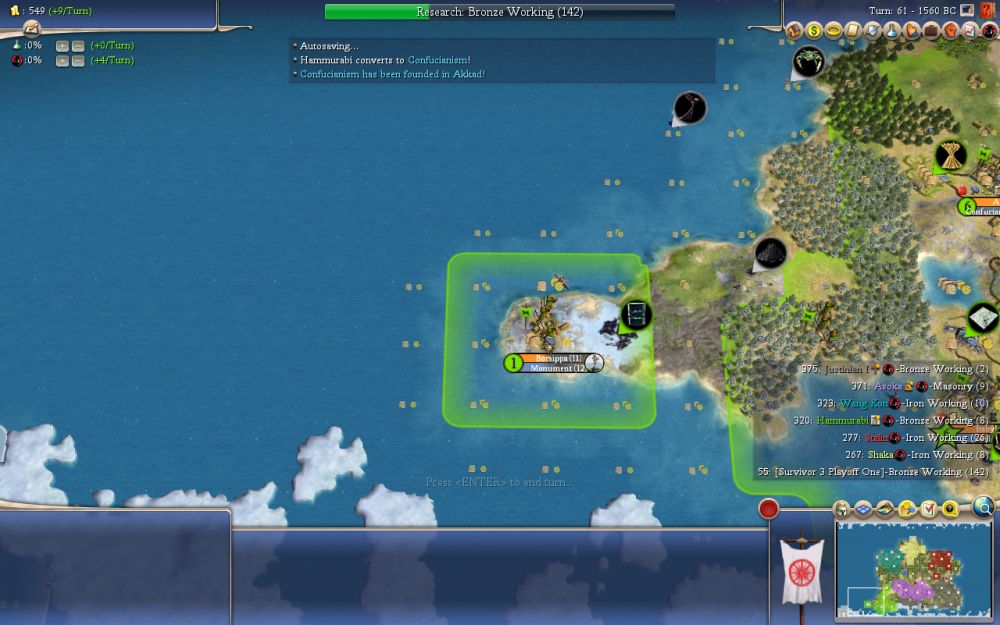

Shaka of the Zulus
Wars Declared: 55
Wars Declared Upon: 20
Survival Percentage: 40%
Finishes: 0 Firsts, 5 Seconds (10 points)
Kills: 8
Overall Score: 18 points
Unfortunately for the fan favorite warmonger, Shaka was saddled with the worst position in the map and had no easy targets. Of his three neighbors, Wang Kon was a Protective leader with good defensive terrain, Stalin was his only natural ally, and Asoka had so many enemies that the Zulu could only get so much from the partition. Moreover, he had little space, the land he did have was of low quality, and his overall economic capabilities were not good enough to get him out of this pickle. Shaka's best hope for a championship spot was to kill Wang Kon earlyish and ride that to a Runner Up finish behind Justinian or Stalin, and this happened five times. Otherwise, he was either a stepping stone for one of his neighbors or an impediment to the Empire's plans. That's all she wrote - this was an unremarkable and rather pathetic set from a normally interesting and dynamic leader.
Best Performance: In Game 10, Shaka murdered the Troll King early and snowballed… into a 2nd place finish. In truth, his best game out of all 21 iterations was the Actual Game, where he did become the largest civ and only got eliminated due to a Stalin-Justinian Defensive Pact (he might have actually won if left alone 1v1 against someone). Shaka was never even close to that strong in the Alternate Histories.
Worst Performance: Failing to take down a three city Wang Kon in Game 2.
Darth Troaul Award: In Game 12, Shaka dragged Justinian into a Defensive Pact triggered war against a runaway Stalin. This ended up pulling Justinian from clear cut 2nd place into a one city rump state, paving the way for a very undeserving Shaka championship appearance.

Asoka of India
Wars Declared: 8
Wars Declared Upon: 59
Survival Percentage: 20%
Finishes: 0 Firsts, 4 Seconds (8 points)
Kills: 1
Overall Score: 9 points
A major reason why I felt that this set overestimated Justinian's strength in this setup: in the first four games, Asoka's economic mismanagement ranked among some of the worst I have ever seen from a high peaceweight leader. In those initial games, the Indian leader had crashed his economy from overexpansion and bad research priorities and was lacking essential techs like The Wheel and Pottery on Turn 100. He also lost a city to the barbarians in Game 1. It was no accident that Justinian majorly cooled off once Asoka finally relearned how to play Civilization IV.
In a typical game, Asoka was always one of the three strongest leaders after the early game. However, Asoka still chose questionable spots for city settlements, leaving him with a difficult to defend empire. In particular, he liked to settle one of his border cities next to Justinian in a flood plain site on the Byzantine side of the river, and that city was often the first to fall once the Eastern Romans came calling. As it turns out, the high ground matters more than you think. Facing invasion after invasion after invasion (his 59 defensive wars felt quite low considering how much fighting he did), Asoka was in an impossible position. There were multiple games where Asoka was able to hold off one leader, only for the next wave of enemies to cause the whole house of cards to collapse. Like his fellow Jedi, Asoka was also too steeped in his dogma, leaving him even more vulnerable.
However, if Asoka could hold on for 200 turns, his outlook became much rosier. For whatever reason, he still died in the Hammurabi games (I think a strong Hammurabi tended to mean a weaker Asoka), but in the Wang Kon games, Asoka served as the perfect Padawan for the Troll King, holding the bad guys at bay while the Koreans brought balance to the Force. In fact, all four of his second-place finishes came behind Wang Kon - he was too exhausted from fighting to be anything more. This gave him the unique distinction of either dying or getting 2nd place, certainly an interesting binary. Favoring a peaceful strategy yet also bordering three enemies (sometimes four if one of the Western leaders adopted a different religion) would be a tough task for any, and considering his position, he did about as well as he could. Ultimately, this was a gutsy set from someone perhaps unfairly marked as a lesser Gandhi.
Best Performance: As I had mentioned, Asoka should have gotten his revenge and won Game 19, but the Master of Troll just had to Troll.
Worst Performance: Asoka was beyond useless as a meat shield in Game 9. That game in general was a doozy for the Jedi, who wasted time on pointless cross map excursions.
Taking The Rejection Of Possessions Too Seriously Award:
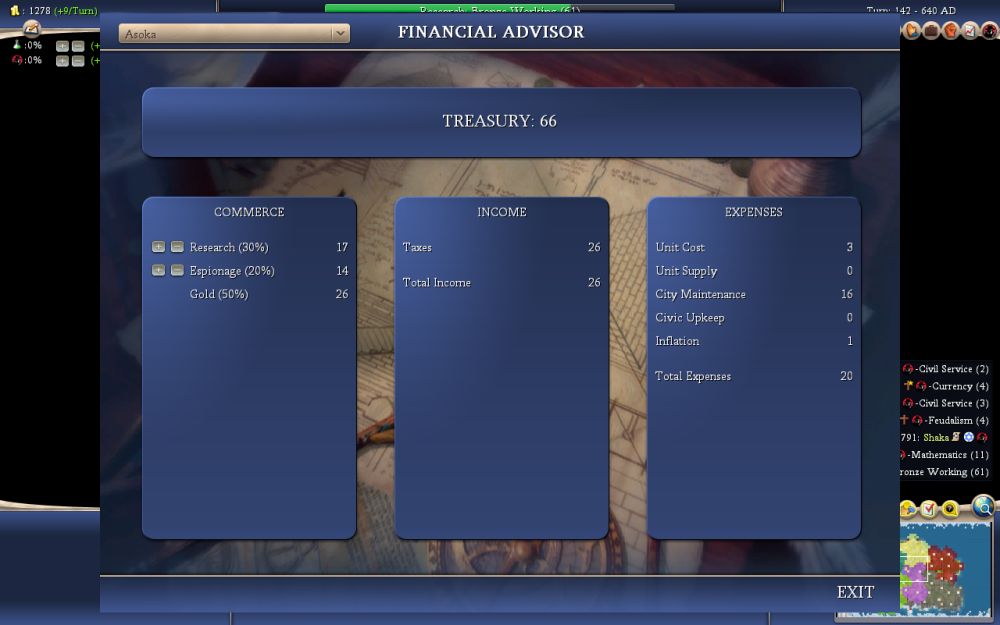
Enlightened Monty Award:
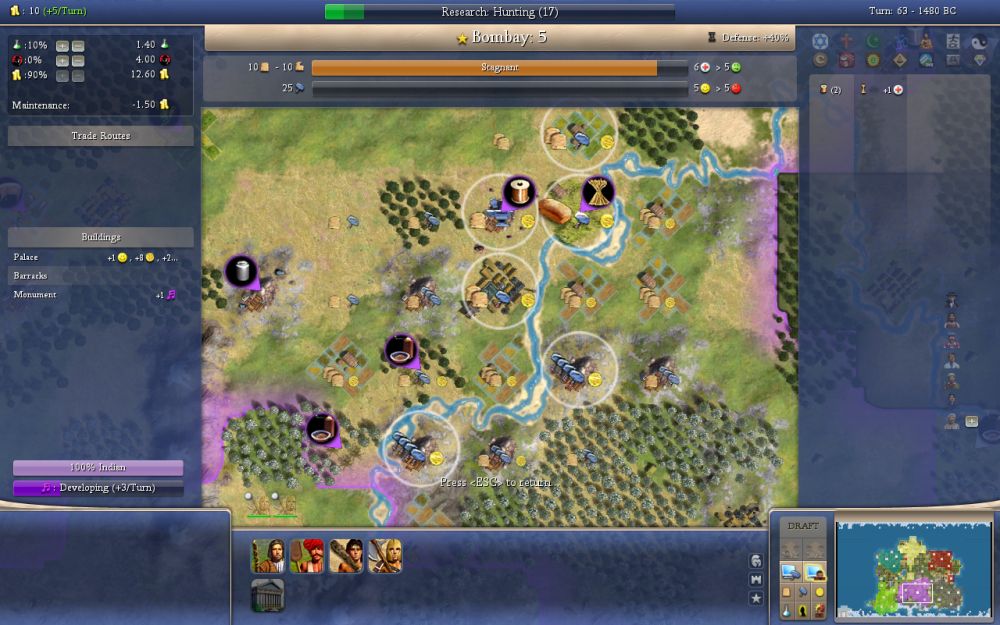

This was an incredibly fun set to run, one that rekindled my passion for AI Survivor. The good vs. bad guy dynamics of this map were extremely compelling, and I especially enjoyed rooting for the Troll King underdogs in these games. Considering the surprising viability of the high peaceweight leaders, this was an interesting "what could have been" regarding Mansa's chances at winning his first title. We all know the hopeless diplomatic position he found himself in the Championship Game, and things would have been quite different had Wang Kon and Asoka instead occupied Stalin's and Justinian's spots.



